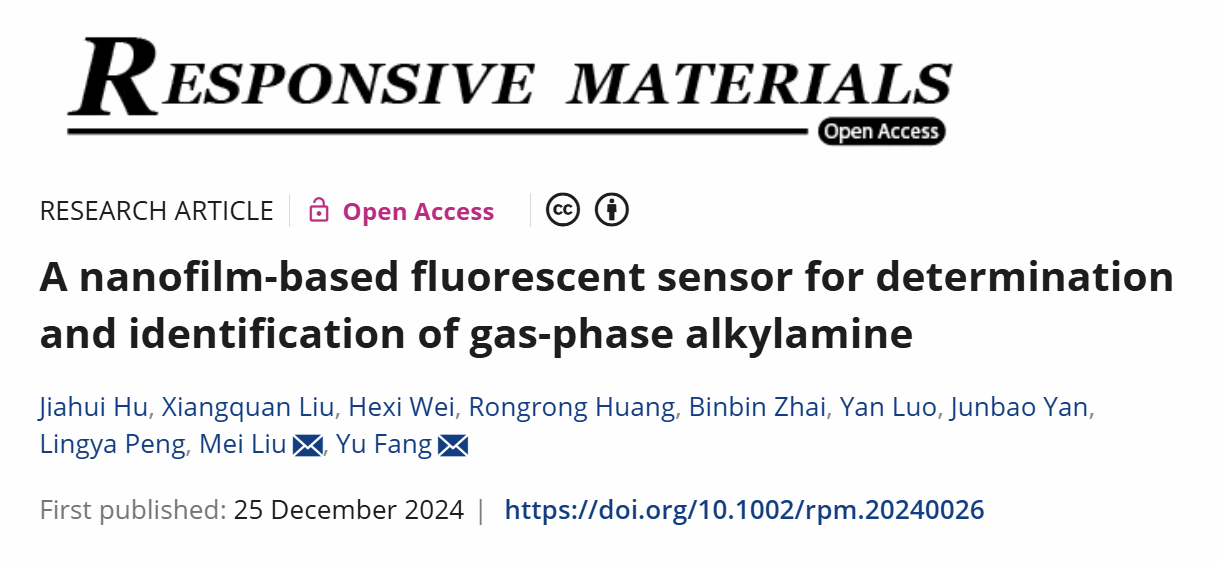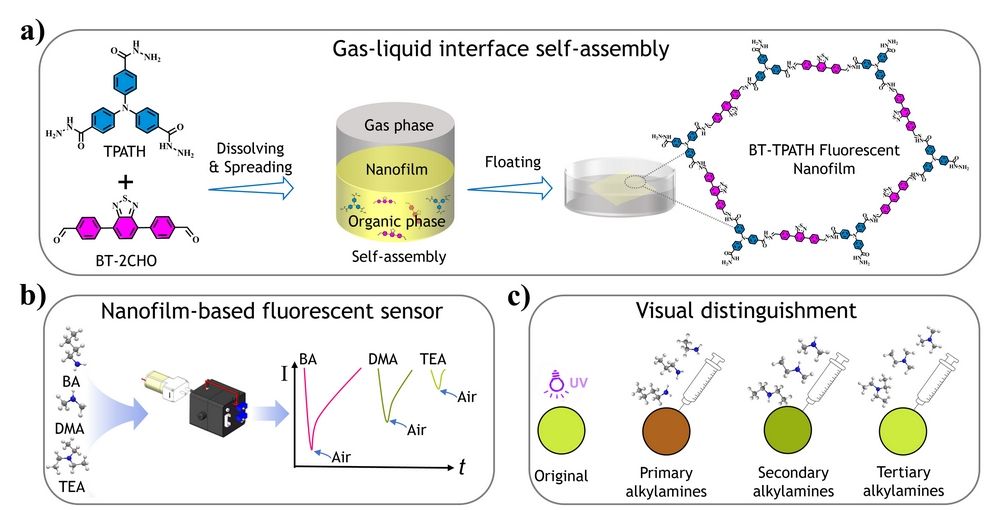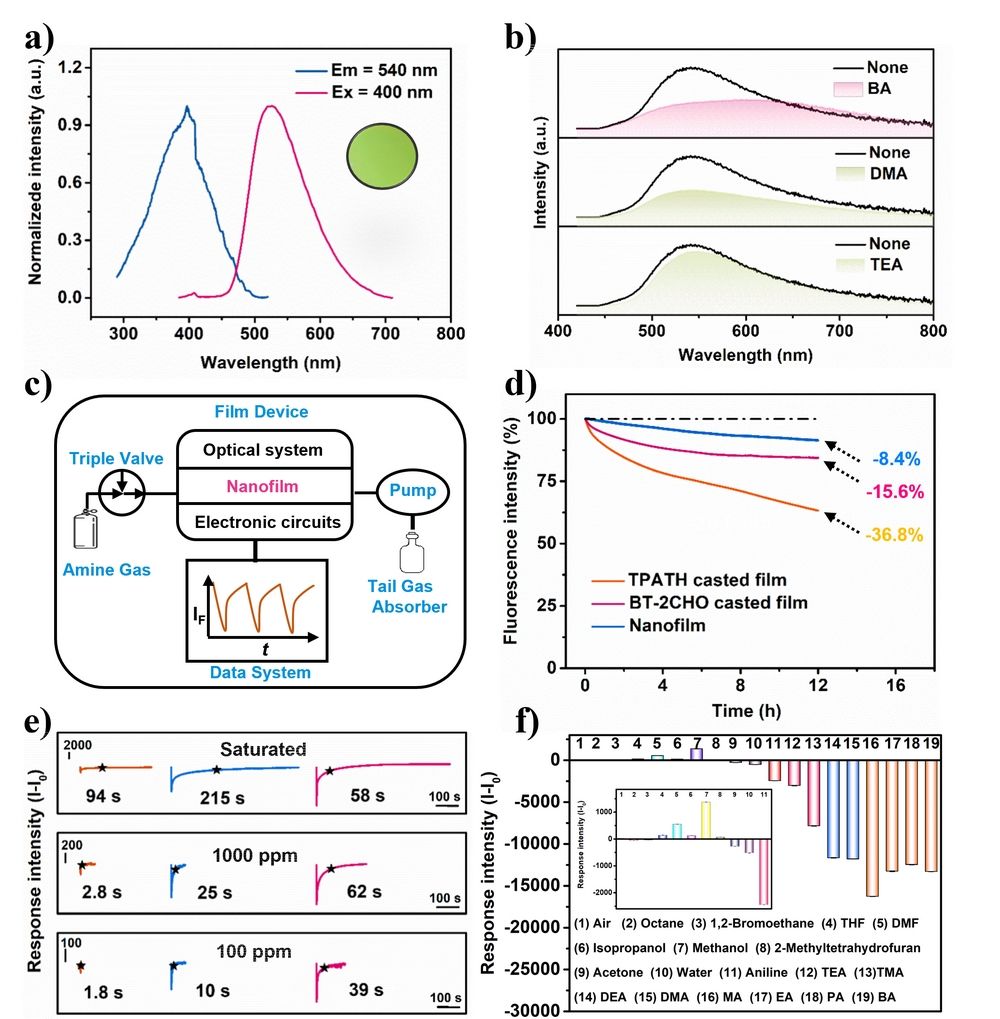
Jiahui Hu, Xiangquan Liu, Hexi Wei, Rongrong Huang, Binbin Zhai, Yan Luo, Junbao Yan, Lingya Peng, Mei Liu, Yu Fang, Responsive Mater. 2024, e20240026. DOI:10.1002/rpm.20240026.

Volatile alkylamines constitute essential raw materials and transitional compounds within the domains of chemical, pharmaceutical, and agricultural industries. Nonetheless, their toxicity presents serious occupational safety risks. Continuous exposure to alkylamine vapors can induce ocular, nasal, and pharyngeal irritation, headaches, facial erythema, as well as the development of neurological disorders. The rapid and portable detection of volatile alkylamines is essential for mitigating their adverse impacts on human health, as well as for advancing research in atmospheric particle formation, early disease diagnosis, and food spoilage monitoring.

Figure 1. (a) Structures of the building blocks & schematic representation of the preparation of the nanofilm at the humid air/DMSO interface. (b) Schematic diagram of a nanofilm-based fluorescence sensor for efficient detection and distinguishment of alkylamines. (c) Schematic diagram of visual differentiation of primary, secondary, and tertiary alkylamines by the prepared nanofilm. DMSO, dimethyl sulfoxide.

Figure 2. (a) Fluorescence excitation (blue line) and emission (red line) spectra of the nanofilm (λex = 400 nm, λem = 540 nm). (b) Fluorescence emission spectra of the BT-TPATH nanofilm before and after exposure to saturated butylamine (BA), dimethylamine (DMA), and triethylamine (TEA) vapors (λex = 400 nm). (c) Schematic of the sensing device, which mainly consists of three parts, a gas supply unit, the nanofilm-based sensor, and a data collection system. (d) Changes in the fluorescent emission intensity of the fabricated nanofilm (black line) and the relevant films continuously monitored under UV light illumination (λex = 400 nm) for 12 h. (e) Recovery times for 90% signal recovery of BA (red line), DMA (blue line), and TEA (orange line) at three different concentrations: saturated concentration, 1000 ppm, and 100 ppm. (f) Responses of the nanofilm-based fluorescent sensor to various alkyl amines and some potential interferences. The “star” symbol in Figure 2e stands for the point at which the fluorescence intensity recovers to 90% of its initial value. (h) Two-dimensional PCA score plot for discriminating the tested chemicals.
Herein, we specially designed and prepared a novel fluorescence nanofilm of BT-TPATH via dynastic condensation of electron-rich 4,4',4''-nitrilo-tribenzohydrazide (TPATH) and electron-deficient 4,7-diphenylaldehyde-benzothiadiazole (BT-2CHO) at the air/DMSO interface. The nanofilm as prepared exhibits distinct fluorescent responses to primary, secondary, and tertiary alkylamine vapors. Leveraging the unique response of the BT-TPATH nanofilm to alkylamines, a BT-TPATH nanofilm-based FFS was developed. This sensor not only provides a fast and reversible response to a range of alkylamines but also differentiates between primary, secondary, and tertiary alkylamines based on their unique recovery times and response intensities. Theoretical calculations suggest that hydrogen bonding interaction and microenvironment effects account for the observed red-shift and quenching of the nanofilm’s fluorescence. Compared to traditional methods, this FFS offers a rapid, reversible, and convenient approach for the detection and differentiation of alkylamines. We believe the matchless distinguish ability of the sensor as developed holds great potential for key applications, such as rapid monitoring of food freshness, disease diagnosis, and safety assessments in various industrial processes.
First Author: Hu Jiahui, Master’s candidate, Shaanxi Normal University
Correspondence Authors: Prof. Fang Yu, A/Prof. Liu Mei, Shaanxi Normal University
Full Text Link: https://doi.org/10.1002/rpm.20240026